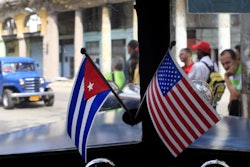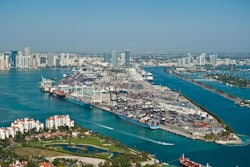
As part of President Obama's historic trip to Cuba to further normalization of relations, advance commercial and people-to-people ties, and express our support for human rights for all Cubans, Agriculture Secretary Tom Vilsack today announced several measures that will foster further collaboration between the U.S. and Cuban agriculture sectors. The two neighboring countries share a common climate and agriculture-related concerns, and the measures announced today in Havana will mutually benefit the Cuban people and U.S. farmers and ranchers.
While in Cuba, Secretary Vilsack announced that USDA will allow the 22 industry-funded Research and Promotion Programs and 18 Marketing Order organizations to conduct authorized research and information exchange activities with Cuba. These groups, which are responsible for creating bonds with consumers and businesses around the world in support of U.S. agriculture, will be able to engage in cooperative research and information exchanges with Cuba about agricultural productivity, food security and sustainable natural resource management. Secretary Vilsack called the announcement "a significant step forward in strengthening our bond and broadening agricultural trade between the United States and Cuba."
During their bilateral meeting today, Secretary Vilsack and Cuban Minster of Agriculture Gustavo Rodriguez Rollero will sign a Memorandum of Understanding that establishes a framework for sharing ideas and research between the two countries. Secretary Vilsack also has invited Minister Rodriguez to join on a visit to one of USDA's Climate Sub Hubs in Puerto Rico in late May, where USDA researchers are studying the effects of climate change in the subtropical region and strategies for mitigating these effects.
"Recognizing the importance of agriculture in the United States and Cuba, USDA is advancing a new partnership for the 21st century between our two countries," said Vilsack. "U.S. producers are eager to help meet Cuba's need for healthy, safe, nutritious food. Research and Promotion and Marketing Order Programs have a long history of conducting important research that supports producers by providing information about a commodity's nutritional benefits and identifying new uses for various commodities. The agreements we reached with our Cuban counterparts on this historic trip, and the ability for our agriculture sector leaders to communicate with Cuban businesses, will help U.S. agricultural interests better understand the Cuban market, while also providing the Cuban people with science-based information as they grow their own agriculture sector."
USDA will review all proposed Research and Promotion Board and Marketing Order activities related to Cuba to ensure that they are consistent with existing laws. Examples of activities that may take place include the following:
- Provide nutritional research and guidance, as well as participate with the Cuban government and industry officials, at meetings regarding nutrition and related Cuban rules and regulations.
- Conduct plate waste study research in schools to determine what kids eat and what they discard, leading to improved nutritional information that helps develop the guidance for school meal requirements, ensuring kids are getting adequate nutrition to be successful in school.
- Provide U.S. based market, consumer, nutrition and environmental research findings to the Cuban government and industry officials.
- Research commodities' role in a nutritious diet that improves health or lowers the risk of chronic diseases.
- Study the efficacy of water disinfectants to eliminate/inactivate bacteria on commodities.
- Test recipes and specific products amongst Cuban consumers of all ages, with the goal of increasing product development and acceptance.
- Conduct consumer tracking studies to measure attitudes when it comes to a specific commodity and consumption and to identify consumer groups based on their behavior, attitudes, and purchasing habits for a particular commodity.
The visit to the Puerto Rico Sub Hub would allow USDA and Cuba's Ministry of Agriculture to exchange information on climate change as it relates to tropical forestry and agriculture, and explore opportunities for collaboration. The two officials would be able to explore tools and strategies to cope with challenges associated with climate change, such as drought, heat stress, excessive moisture, longer growing seasons, and changes in pest pressure.
The Puerto Rico hub is part of the USDA Regional Climate Hub network that supports applied research and provides information to farmers, ranchers, advisors, and managers to inform climate-related decision making. The hubs are an invaluable resource for those seeking to understand the specific risks of climate change, as well as region-specific adaptation strategies.
The agriculture and forestry sectors in the Caribbean are especially vulnerable to the effects of climate change. Not only is the region particularly exposed to extreme weather events, but much of its population and prime agricultural lands are located on the coast. The Puerto Rico Sub Hub is specifically focused on addressing these unique challenges and supporting the people and institutions involved in tropical forestry and agriculture.
While most U.S. commercial activities are prohibited, the Trade Sanctions Reform Act (TSRA) of 2000 permits the export of U.S. agricultural commodities, though U.S. agricultural exports to Cuba are limited by U.S. restrictions on government export assistance, cash payments, and extending credit. U.S. agricultural exports have grown significantly since trade was authorized in 2000. In 2014, Cuba imported over $2 billion in agricultural products including $300 million from the U.S. However, from 2014 to 2015, U.S. agricultural exports to Cuba fell 48 percent to $148.9 million, the lowest since 2002, giving the U.S. just a 10 percent market share as Cuba's fourth largest agricultural supplier, behind the EU, Brazil, and Argentina.
This historic visit to Cuba is the first by a sitting U.S. President in nearly 90 years. It is Secretary Vilsack's second visit and is another demonstration of the President's commitment to charting a new course for U.S.-Cuban relations and connect U.S. and Cuban citizens through expanded travel, commerce, and access to information.














